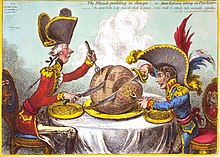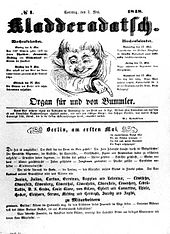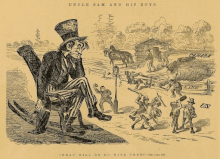cartoon
Caricature (from Latin carrus 'cart', also: overload, and Italian caricare 'overload', 'exaggerate') means the comically exaggerated depiction of people or social conditions, also with a political or propagandistic background. The draftsmen of ( pictorial ) caricatures are called caricaturists , the drawing caricatures . The English equivalent is caricature .
To the subject
Caricatures are mostly a pictorial form of satire , which sees itself as a partisan criticism of existing values or political conditions and is often used as a "weapon" in social disputes. The caricature deliberately exaggerates, exaggerates and distorts characteristic features of an event or a person in order to induce the viewer of the caricature to think through the contrast to reality and the contradictions shown. The caricature often takes a sarcastic and ironic position on a current issue . Significant errors and deficiencies in the person portrayed (e.g. a politician) or in the portrayed object or event are uncovered and made ridiculous by the manner in which they are usually presented in drawings. The caricature can be more satirical or more humorous , depending on whether it completely condemns and ridicules its victim or - as a mere joke - only wants to comment on a few shortcomings with gentle irony .

In addition to these political caricatures, there are portrait caricatures that deal exclusively with the physiognomy of people or their faces. The aim here is to highlight the distinctive facial features without losing the recognizability of the person. The caricaturist often tries to portray typical character traits, public perception or a subjective interpretation of the caricatured person. This category also includes caricatures made by street artists in tourist locations, such as the Place du Tertre in Montmartre , or in theme parks. Here one also speaks of quick draftsmen .
History of caricature

The first caricatures are said to have existed in antiquity. Caricature-like representations were occasionally found on ancient Egyptian papyri , Greek vases or as Roman wall paintings . In medieval churches satirical motifs can be found on the capitals of the columns or in the illumination . During the Reformation , representatives of Protestantism and Catholicism were roughly caricatured on leaflets by the respective opposing side (see: " Pope donkey "). Leonardo da Vinci drew some grotesque caricature images of contemporaries. In the 16th century, the brothers dedicated Carracci the portrait caricature . In Holland there were moralizing-satirical graphics in the 17th century. The early modern disgrace with its overdrawing was used as a punitive measure. The actual socially critical caricature developed in Great Britain in the 18th century . One of the forerunners of the modern caricaturists was William Hogarth with his "modern images of life" that were brimming with satirical swipes. He was succeeded by the first political cartoonists in Great Britain, including James Gillray , Thomas Rowlandson and later George Cruikshank , who drew caricatures against the British royal family, against British politicians and against the French Revolution .
In France , caricature drawing flourished in the 19th century. Outstanding draftsmen like Honoré Daumier or Grandville criticize the philistine bourgeoisie in satirical papers like La Caricature and Le Charivari . The caricature of the French King Louis-Philippe I as "pear" leads to a criminal case for Charles Philipon . Similar papers appear in other countries: the Punch in London , the Fliegende Blätter and the Simplicissimus in Munich or the Kladderadatsch in Berlin .
Today there are also a large number of well-known cartoonists outside of Europe. In Egypt, for example, Andeel , Tarek Shahin and Mohamed Anwar.
Modern cartoon typology

With regard to the formal structure of representation, a distinction is made between non-personal factual caricature, personal type caricature and personal individual caricature. The factual caricature is the least common. Although it mostly aims at politically personal action, it relates its statements primarily to things or objects that the viewer can easily associate with certain people. The personal type caricature deals with states, peoples, social groups, institutions and associations. There is a certain figure in these caricatures, for example: As representative of a state or the people of a particular nation: Sun represents the " Michel " the Germans or Germany, " Marianne ", the French or France, the " Yankee " the Americans or the United States, posh wardrobes cylinder the entrepreneur , Dungarees and hard hats for workers, lederhosen for Bavarians, etc. Animal figures can also take on such representational functions: Examples are the British or Bavarian lion, the Russian or Berlin bear , the Chinese dragon, etc.
The most common is personal caricature . Well-known politicians are often caricatured and given individual, unmistakable facial features, shape or clothing features by the caricaturist, so that the person portrayed can be clearly identified. Certain features of the politician's face - the shape of the hair, a long nose, a prominent chin, etc. - are exaggerated in order to increase recognition. Additional typical attributes ensure the general recognition of the caricatured person. Well-known caricaturists such as Horst Haitzinger , Frank Hoppmann or Bernhard Prinz characterize their “victims” with their personal stylistic touch.
In terms of content, three types of caricature can also be distinguished: the event caricature, the process caricature and the state caricature.
The caricature of an event takes a punctual occurrence, such as a daily event that is temporarily topical, z. B. the result of an election, the overthrow of a government, a political incident, a political speech, etc. The process cartoon aims at historical change, wants to highlight turning points, to mark ascent and descent, deals with the before and after or confronts ideas with the Reality. Such caricatures often appear in a two-part or multi-part sequence and look back at the past from the present. The state caricature usually takes up current issues, but tries to satirically attack permanent, little changeable, conservative structures from them, such as existing rule, social or economic systems. This also includes the panorama caricatures, which aim to characterize a general and long-term political situation that goes beyond the daily news.
Well-known awards for cartoonists
- since 1995 the eoplauen award and the eoplauen advancement award
- since 1996 the German Prize for Political Caricature
- since 1998 the caricature award of the German legal profession
- since 2000 the German Caricature Prize
- since 2000 the Ranan Lurie Political Cartoon Prize of the United Nations Correspondents Association named after Ranan Lurie
Caricature museums in German-speaking countries
- Caricatura Kassel
- Cartoon Museum Basel
- Caricatura Museum for Comic Art in Frankfurt am Main
- Wilhelm Busch - German Museum for Caricature and the Art of Drawing in Hanover
- Caricature Museum Krems
- Satiricum in the summer palace Greiz
International cartoon museums
In contrast to the German-speaking countries, classical / serious art and entertainment art are not so clearly separated from each other internationally. Therefore, in addition to caricatures, there are also various cartoons in many museums.
The most famous international cartoon museums are:
- The Cartoon Museum (London)
- Cartoon Art Museum ( San Francisco )
- ToonSeum ( Pittsburgh )
- Israeli Cartoon Museum ( Israel )
Caricature in other media fields

Er: What? Is that Marie, Frau Burgbichlerin?
Mother: Yes, but it is - if it would never have known soon, Mr. Refiser
he: God! Yes, as I traveled away, you were still very small but where you are grown up - and - just like mom!
Caricature is also used when an object is shown in media other than the visual arts in such a way that certain defects or peculiarities emerge, so that the overall picture appears intentionally distorted.
Examples in drama:
- Shylock in Shakespeare's The Merchant of Venice .
- Riccaut de la Marlinière in Lessing's Minna von Barnhelm .
Example in lyric:
- Matthias Claudius ' poem Now I don't want to live any longer either, following the review of Goethe's The Sorrows of Young Werther .
Examples in music:
- Wolfgang Amadeus Mozart A musical fun .
- In the fifth movement of his Symphonie Fantastique, Hector Berlioz caricatures a leitmotif from the preceding movements and the theme of the liturgical Dies irae .
- Paul Hindemith around 1925: Overture to the “Flying Dutchman”, as played by a bad spa band at 7 am at the fountain from the sheet
Well-known caricatures
- The pilot disembarks , a caricature of Otto von Bismarck's resignation
- The Rhodes Colossus , a cartoon about British colonialism
- The face of Muhammad in the Danish daily newspaper Jyllands-Posten
Related art forms
Literature and Documentaries
- The cartoon: Art and Provocation !, France 2015
- Friedrich Bohne (ed.): The German in his caricature. A hundred years of self-criticism . Commented by Thaddäus Troll with an essay by Theodor Heuss . Klagenfurt: Eduard Kaiser, [approx. 1964]. Stuttgart: Friedrich Bassermann, [approx. 1963].
- Hubertus Fischer; Florian Vaßen (ed.): European caricatures in the pre and post March . Bielefeld: Aisthesis, 2006. (Forum Vormärz Research, Yearbook 11, 2005). ISBN 3-89528-566-8 .
- Eduard Fuchs : The caricature of the European peoples . Vol. 1: From ancient times to modern times. Vol. 2: From 1848 to the present. Berlin: Hofmann, 1901–1903.
- Thomas Knieper : The political caricature: A journalistic form of representation and its producers . Cologne: Herbert von Halem Verlag, 2002.
- Joël Kotek : Au nom de l'antisionisme. L'image des juifs et d'Israel dans la caricature depuis la seconde Intifada . [= In the name of anti-Zionism. The image of the Jews and Israel in the caricature since the Second Intifada. ] Brussels; Paris: Editions Complexe, 2002, 2004, ISBN 2-87027-999-X (French with many examples, mainly from Arabic media.)
- Chris Lamb : Drawn to Extremes: The Use and Abuse of Editorial Cartoons . New York: Columbia University Press, 2004.
- Günter and Ingrid Oesterle: caricature . In: Joachim Ritter; Karlfried Founder: Historical Dictionary of Philosophy […]. Vol. 4. Basel; Darmstadt 1980, Col. 696-701.
- Andreas Platthaus: That catches the eye. The story of the caricature. AB - The Other Library , Berlin 2016, ISBN 978-3-8477-0381-5 .
- (Cillie) Cäcilia Rentmeister : Honoré Daumier and the Ugly Sex. Women's movement in 19th century caricature . In: Honoré Daumier and the unsolved problems of civil society. Berlin 1974; Stuttgart 1975; Graz 1977. (full texts at www.cillie-rentmeister.de )
- Franz Schneider: The political cartoon . Munich: CH Beck, 1988.
- Friedrich Wendel : The nineteenth century in the caricature. Dietz Nachf., Berlin 1925.
- the same: the bell ringing. Cultural caricatures of the 19th century. Berlin 1927.
- Fritz Wolf : The Art of Caricature . Edited by the Fritz Wolf Society. Bramsche: quickly, 2008.
- DVD-ROM caricatures - criticism of time with wit . Edited by the Yorck Project, Society for Image Archiving. Berlin 2004, ISBN 3-936122-18-0 . Catalog of the DNB .
- Zibaldone No. 38: Caricatures: From Bernini to Forattini . Tübingen: Stauffenburg, 2004, ISBN 3-86057-977-0 . (Essays on the past and present of caricature in Italy.)
Web links
- Philippe Kaenel: caricature. In: Historical Lexicon of Switzerland .
- Analysis and interpretation of caricatures (private side)
- Angelika Plum: The caricature in the field of tension between art history and political science. An iconological study of the enemy in caricatures . ( Memento from March 31, 2014 in the Internet Archive ) Dissertation, RWTH Aachen 1997, 383 pages (PDF, 5.1 MiB)
- Reinhard Ahlke: Caricature as a historical source
- Example of an analysis of the cartoon "The pilot disembarks"
- Page about dance and caricature at the German Dance Archive Cologne
Individual evidence
- ^ "9 Egyptian Comic Artists You Should Know About" , Cairo Gossip , March 14, 2016.
- ↑ International cartoon museums. (No longer available online.) Archived from the original on February 16, 2018 ; accessed on February 15, 2018 .




